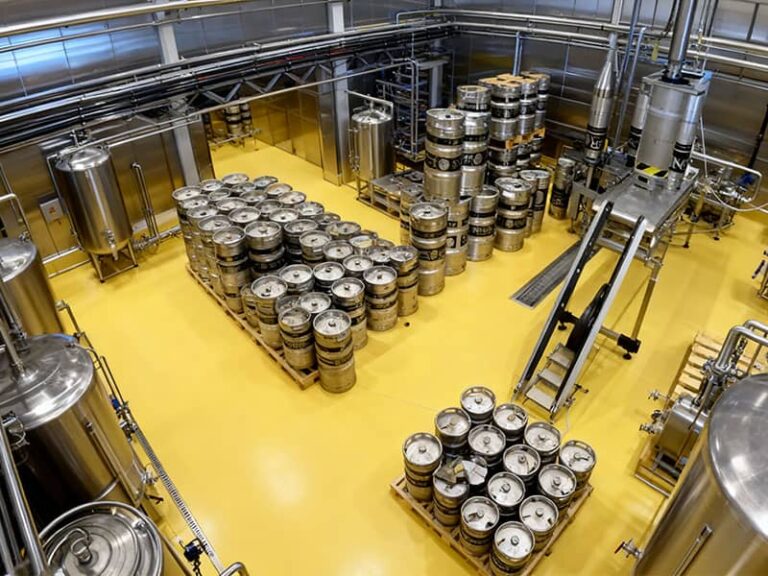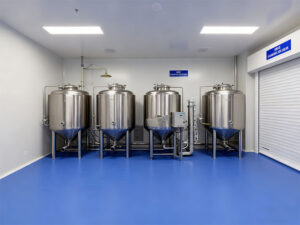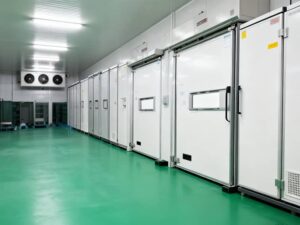Designing a urethane brewery floor requires a meticulous approach that balances extreme chemical resistance, worker safety, compliance with food-grade standards, and long-term durability. A well-designed urethane (polyurethane) mortar floor system provides a seamless, impervious surface that can withstand the harsh conditions of a brewery or beverage production facility, protecting your investment and ensuring operational continuity.
This definitive guide walks you through the five critical phases of designing a superior urethane brewery floor: Comprehensive Site Assessment, Performance Specification, System Selection, Professional Installation, and Rigorous Quality Control. We will cover the essential principles, specifications, and comparative data to help you make an informed decision.
Why a Urethane Floor is the Optimal Choice for Breweries
Industrial urethane flooring systems outperform traditional materials like epoxy because of their unique blend of flexibility, thermal stability, and exceptional resistance to chemicals commonly found in breweries. Their molecular structure offers superior durability against acids, caustic cleaners, and sugars, while their inherent flexibility allows them to withstand thermal cycling and minor substrate movement without cracking—a common failure point for rigid coatings.
Key Advantages of Urethane Floors:
- Superior Chemical Resistance: Resists prolonged exposure to beer, wort, acidic cleaners (CIP chemicals), and caustic solutions. According to industry analysis, industrial cementitious polyurethane is a popular choice for the food and beverage sector due to its higher strength and improved chemical resistance compared to epoxy or polyester alternatives.
- Exceptional Thermal Shock Resistance: Formulated to handle extreme temperature fluctuations, from hot washdowns (up to 120°C) to cold storage conditions, without degrading.
- High Mechanical Strength: Offers outstanding abrasion and impact resistance, protecting the floor from heavy traffic, dragging kegs, and dropped tools.
- Seamless & Hygienic Surface: A non-porous, monolithic surface prevents microbial growth and is easy to clean and steam, meeting USDA and FDA guidelines for incidental food contact.
Step 1: Conduct a Thorough Site and Substrate Assessment
The success of any urethane brewery floor installation is contingent on the condition of the concrete substrate. A flawed slab will compromise even the best flooring system.
Critical Evaluation Checklist:
- Moisture Vapor Emission Rate (MVER): Test using ASTM F1869 (Calcium Chloride) or F2170 (In-situ Probe). A high MVER can cause blistering and adhesive failure. Most industrial urethane systems require a maximum of 3-5 lbs per 1,000 sq. ft. per 24 hours, but always adhere to the manufacturer’s specifications.
- Surface Strength: The concrete must have a minimum compressive strength of 3,500 psi to adequately resist the stresses of the coating system.
- Cracks and Joints: Map all control joints, construction joints, and cracks. Determine if they are active or dormant to plan for appropriate crack-bridging strategies using flexible sealants.
- Slope and Drainage: Ensure the floor has a minimum slope of 2% (1/4 inch per foot) towards drains to prevent water pooling, a critical factor in brewery hygiene.
Step 2: Define Your Performance Specifications
Before selecting a product, you must define the functional requirements. This blueprint is essential for knowing how to choose flooring for a brewery that will perform for decades.
Performance Requirement Checklist:
- Chemical Load: List all substances (phosphoric acid, caustic soda, hydrogen peroxide, sanitizers, sugars) with their concentrations and contact temperatures.
- Mechanical Load: Define traffic types (forklifts, pallet jacks) and potential impact forces.
- Safety Standards: Specify the required coefficient of friction (COF) for wet and dry conditions. A COF of 0.6 or higher is recommended for wet processing areas to prevent slips and falls.
- Thermal & Hygienic Needs: Define operational temperature ranges and cleaning protocols (e.g., steam cleaning). Specify if food-grade flooring certification is required.
Step 3: Select the Appropriate Urethane Flooring System
Not all urethane systems are identical. The choice depends on the specific demands identified in your performance specifications.

Common Urethane System Types for Breweries:
- Urethane Mortar Systems (Trowel-Applied): The gold standard for production, packaging, and loading bay areas. These systems, typically 1/4″ to 3/8″ thick, offer the highest resistance to extreme impact, abrasion, and thermal shock. Their seamless nature is ideal for hygienic flooring.
- Self-Leveling Urethane Systems: Provide a perfectly smooth, seamless surface for fermentation cellars and areas where ultra-hygienic properties and ease of cleaning are the top priorities.
- Urethane Topcoats: Used as a protective wear layer over other systems or in light-duty areas for enhanced chemical and abrasion resistance.
Urethane vs. Epoxy Flooring: A Data-Driven Comparison for Breweries
A critical question in brewery floor design is: urethane flooring vs epoxy for breweries? The following table, based on industry data and case studies, outlines the key differences.
| Proprietà | Pavimenti in uretano | Pavimentazione epossidica |
|---|---|---|
| Flexibility & Crack Bridging | Alto | Rigid (Prone to cracking with substrate movement) |
| Resistenza chimica | Excellent against a broad range of acids and caustics | Good, but can degrade with certain acids |
| Thermal Shock Resistance | Excellent (Withstands rapid temperature changes) | Poor to Fair (Can soften or crack) |
| Resistenza all'abrasione | Excellent (Typically >100 mg on Taber test) | Good (Typically 60-90 mg on Taber test) |
| Application Temperature | Can be applied in low temperatures (as low as 23°F / -5°C) | Requires warmer temperatures (>50°F / 10°C) |
| Typical Cure Time | Rapid cure; can be serviceable in 8-12 hours | Longer cure times (24-72 hours) |
Step 4: Execute a Meticulous Installation Process
The best urethane flooring will fail if installed incorrectly. Professional installation is non-negotiable.
The Installation Workflow:
- Substrate Preparation: Diamond grinding or shot blasting to create a clean, profiled surface for maximum mechanical adhesion.
- Crack & Joint Treatment: Routing and filling active joints with a high-quality, flexible sealant to allow for movement.
- Primer Application: A compatible primer is applied to penetrate the concrete and enhance bond strength.
- Body Layer Application: The urethane mortar or self-leveling compound is troweled or poured to the specified thickness. This layer provides the system’s structural durability.
- Topcoat Application: A seamless, chemical-resistant urethane topcoat is applied to provide the final, impervious, and easy-to-clean wear surface.
Step 5: Implement Quality Control and Proactive Maintenance
The final phase ensures the floor performs as designed throughout its lifecycle. A proper maintenance regimen is crucial for longevity.
QC & Maintenance Protocol:
- Post-Installation Inspection: Verify thickness, adhesion (via pull-off test per ASTM D7234), and visual consistency.
- Tempo di polimerizzazione: Allow the system to fully cure before subjecting it to full operational loads. Some systems allow foot traffic in 8 hours and forklift traffic in 48 hours-2.
- Routine Cleaning: Use pH-neutral cleaners. Avoid undiluted acids or harsh solvents.
- Scheduled Inspections: Conduct bi-annual inspections for signs of wear or damage to address issues proactively.
Domande frequenti (FAQ)
Q: What is the typical lifespan of a urethane brewery floor?
A: With a proper design, professional installation, and consistent maintenance, a high-quality urethane mortar system can last 15-20 years or more in a demanding brewery environment, representing a strong long-term investment.
Q: Are urethane floors slippery when wet?
A: Not when specified correctly. Urethane systems can be formulated with aggregates to create a textured, slip-resistant surface. For areas that are frequently wet, specify a system with a wet COF of 0.6 or higher to ensure worker safety.
Q: Can a urethane floor be installed over an existing epoxy floor?
A: It is technically possible if the existing epoxy is sound, fully adhered, and has been profiled (e.g., by shot blasting) to provide a mechanical key for the new urethane system. A professional assessment is critical in these scenarios.
Engineer a Flawless Foundation with KAIDA PAINT
In the demanding world of brewery and beverage production, your flooring is a critical piece of infrastructure. At KAIDA PAINT, we specialize in developing high-performance polyurethane flooring solutions engineered to meet the exacting standards of the food and beverage industry. Our KAIDA PU 800 Series is not just a coating; it’s a integrated system designed for resilience.
Our unique formulation offers:
- Enhanced Thermal Cycling Performance: Withstands temperatures from -40°C to 120°C, far exceeding industry standards, preventing delamination and cracking.
- Proven Chemical Resistance: Independently tested and certified to resist the specific chemical profile of breweries, including phosphoric acid, caustic soda, and hydrogen peroxide.
- Rapid Cure Formulations: Minimize downtime with our fast-cure options, allowing you to return to production faster without compromising on performance.
We provide more than just product. Our technical support team works with you from the initial brewery flooring design and specification through to installation oversight, ensuring your project is a success.
Ready to design a floor that enhances your operation’s safety, efficiency, and compliance? Contact our flooring experts today for a free, no-obligation consultation and specification guide.







